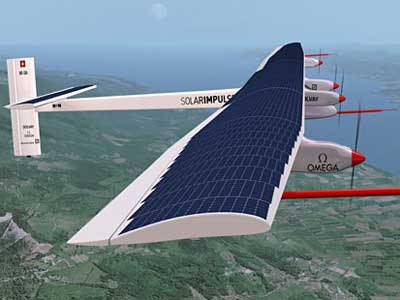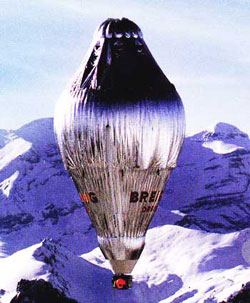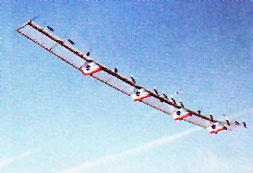HB-SIA "Solar Impulse" Solar-Electric Powered Flight


Unveiled June 26, 2009 the "Solar Impulse" has been in the planning stages since 1999, spear headed by Bertrand Piccard. Making its first flight November 11, 2009, it taxied down the runway only leaving the ground by a few feet. Still in the testing stage of actual flight, the hope of the round the world trip is still in the future.
The HB-SIA nicknamed the "Solar Impulse" is a no-fuel aircraft, only solar powered as the nickname implies. Its creator hopes that it will one day circumnavigate the earth non-stop, but in the near future hopes to at least make the trip in 20 to 25 days with stops.
Solar Impulse
 How far can you go with no fuel? If aeronautical adventurer Bertrand Piccard has any influence, the answer will be: all the way around the world.
How far can you go with no fuel? If aeronautical adventurer Bertrand Piccard has any influence, the answer will be: all the way around the world.
Piccard, 47,hatched his latest scheme while working on the Breitling Orbiter, the hybrid helium/hot air balloon in which he and copilot Brian Jones made a pioneering round-the-world flight in 1999. "All the journalists were saying it was the last possible adventure in the atmosphere," Piccard says. "I thought, 'Well, there must be something else.' I'm not the type of man who accepts that there is no more adventure."
Though the Orbiter had no propulsion, it still required large amounts of propane to generate lift at night. Piccard wondered if it would be possible to make the same trip without burning any fuel at all. He imagined an aircraft that would take off and climb under its own power, using only energy derived from the sun, and stay aloft indefinitely. At night, the aircraft would remain airborne using battery power.
Solar-powered aircraft have flown before. In 1981, inventor Paul MacCready's Solar Challenger flew across the English Channel, and in 2001 NASA's Helios unmanned solar-powered vehicle achieved an altitude of nearly 97,000 ft. But to stay airborne through the darkness of a full night would constitute an unprecedented technical achievement. The proposed aircraft will have to harvest as much solar radiation as possible, store it in extremely high-density low-weight batteries, convert the energy to propulsive force with superb efficiency, and lose as little as possible in aerodynamic drag. When all the components of the plane are integrated, the result will be an aircraft engineered to razor- thin tolerances. Even the pilot's clothing will be made of special lightweight material. When Piccard conceived the idea, the necessary technology didn't yet exist.
Of course, that didn't deter him from believing it was possible. At the Paris Airshow this past June, Piccard unveiled a mockup of his concept, the Solar Impulse; he hopes to begin its construction in early 2007, and start making short flights in 2008. The system's critical test will come with the first overnight flight. With that accomplished, the stage will be set for progressively longer trips. And if all goes well, by 2010 the Solar Impulse could be circling the globe.
Piccard, a scion of a family of famous explorers, fell in love with flight at age 16, when he took up hang gliding and micro-flight flying in his native Switzerland. A European aerobatic hang-gliding champion in 1985, he also once held the hang-glider altitude record. In 1992, he was invited to compete in the first trans-Atlantic hot air balloon race. Piccard and his copilot won, setting the stage for his round-the-world challenge in the Breitling Orbiter.
Between his competitive ballooning and his day job practicing psychiatry and psychotherapy, Piccard's busy schedule forced him to leave his solar-airplane idea on the back burner for years. Not until 2003 was he finally able to put together a feasibility study under the auspices of the Ecole Polytechnique Federal De Lausanne (EPFL), Switzerland's equivalent of MIT. The idea that resulted was a twin-engine, single-seat airplane with the 260-ft. wing-span of an Airbus 4380, but weighing 300 times less-just 2 tons, about as much as a midsize car.

Dubbing the proposed aircraft Solar Impulse, Piccard started cobbling together an international confederation of sponsors, advisers and institutional backers, which now include Dassault Aviation, the European Space Agency and EPFL, which had helped him study the thermodynamics of the Breitling Orbiter. He has raised a quarter of the 40 million euros (about $48 million) he'll need to complete the aircraft, and he plans to start 18 months of construction in early 2007 with a workforce of 120 people.
After several revisions, the Solar Impulse concept arrived
at its current form-a sleek, insect like craft with a low-
slung cockpit to prevent contamination of the airflow over
the wing. "Our first design had the cockpit in the nose,
like a motor glider," Piccard says. "Aerodynamically, it was
not good enough. Everything in this airplane needs to be
100 percent optimal-the energy chain, the aerodynamics,
the fabrication of the structure, everything." 
Whether Piccard's dream is attainable with current technology remains an open question. But no less an authority than solar aircraft pioneer MacCready believes Piccard is the person to attempt it. "It won't be easy," he says, "but Piccard, I believe, has the brains to make it happen." From the moment Piccard sat down with his first blank sheet of paper, the project faced one immutable constraint: the sun. Full sunshine carries a good deal of energy- at noon in the tropics, theoretically enough to generate 1.1 hp per square yard. But even today's best solar cells can manage only a 25 to 30 percent conversion efficiency. To generate enough power to run the twin 20-hp electric motors, Solar Impulse's huge wings will be covered with 2690 sq. ft. of monocrystalline silicon solar panels-a tennis court's worth. To take advantage of indirect light reflected off the Earth's surface and to capture low-incident-angle sunlight at twilight, the bottom of the aircraft may also be covered with Graetzel cells, an emerging Swiss-pioneered technology that embeds titanium dioxide and organic dyes within a thin, flexible polymer structure. "They get better efficiency with indirect light than silicon cells do," says Jan-Anders Manson, head of EPFL s Laboratory of Polymer and Composite Technology.
By day, the aircraft's cells will generate a peak output 40 hp, part of which will recharge the 880 pounds of advanced lithium-ion batteries. The rest of the power will be fed to the twin brushless, sensorless DC motors, built for maximum efficiency by Etel of Switzerland (which also built the electric motors for the Huygens probe that landed on Saturn's moon Titan).
Throughout the day, the Solar Impulse will climb, topping out at an estimated 40,000 ft. Maintaining human life in the cold, tenuous atmosphere of that altitude requires energy-and worse, weight. Solar Impulse will have to carry 350 to 450 pounds more than an unmanned craft such as Helios, in the form of the pilot, his gear, life-support systems and emergency equipment. To keep the weight down, the cockpit will have only enough room for the pilot to sit or lie prone. To minimize energy consumption, the team will incorporate many of the lessons it learned while building the Breitling Orbiter. "We'll need to find clever solutions to consume as little energy as possible," says Andre Borschberg, chief executive officer of Solar Impulse. "For instance, instead of heating the cabin, we're going to insulate it. To deal with the humidity generated by the pilot, we'll either use silica gel products or extract it through an active pressurization system."
EPFI's Laboratory of Intelligent Systems is at work on a "symbiotic system" that will integrate communication between the pilot and the aircraft. A biometric suit will relay information about the pilot's physiology to an on- board computer which will monitor his status and activity. For instance, during the deepest part of his sleep cycle, it will allow him to sleep through routine flight, waking him only life's needed at the controls. In turn, interface devices called haptic actuators will allow the pilot to "feel" the status of the airplane. "If there's an overload in one wing, the pilot will feel a vibration, or heat, in his corresponding arm," Piccard explains. "It will really make a complete fusional relation between the plane and the pilot."
Solar Impulse won't stay at its maximum altitude for long. After the sun sinks, the aircraft will draw down its electrical reserves to keep the propellers turning. It also will rely on its second major source of stored energy: gravity. The plane will gradually lose altitude, soaring along at a glide ratio of 40:1-as good as a high-performance glider.
 To obtain that kind of effectiveness, Solar Impulse needs
very large but very light wings. Helios achieved its low
weight at the price of a flexible airframe, which broke up in
flight after turbulence caused it to wobble and buckle. Solar
Impulse's designers plan to build a much stiffer structure
made of carbon fiber. To keep the weight down engineers
will incorporate the solar panels themselves into the composite-materials matrix, providing extra strength to the air-
frame. "Our goal," Manson says, "is to build a structure that
weighs around 5 ounces per
square foot." That sounds light because it is. The advanced
composite hull of the America's Cup-winning yacht Alinghi,
which EPFL also helped to design, weighed five times more.
To obtain that kind of effectiveness, Solar Impulse needs
very large but very light wings. Helios achieved its low
weight at the price of a flexible airframe, which broke up in
flight after turbulence caused it to wobble and buckle. Solar
Impulse's designers plan to build a much stiffer structure
made of carbon fiber. To keep the weight down engineers
will incorporate the solar panels themselves into the composite-materials matrix, providing extra strength to the air-
frame. "Our goal," Manson says, "is to build a structure that
weighs around 5 ounces per
square foot." That sounds light because it is. The advanced
composite hull of the America's Cup-winning yacht Alinghi,
which EPFL also helped to design, weighed five times more.
To minimize drag,the plane will cruise at just under 30 mph at sea level. The custom-designed 12-ft.-dia. propellers will turn at a slow 500 rpm to maximize efficiency. While a tortoise-like pace saves energy, it introduces several problems. One is adverse yaw. When a plane banks into a turn, the aileron on the outside wing causes the wing to generate more lift than its counterpart on the inside wing. More lift equals more drag, which tends to pull the nose away from the direction of the turn. The usual solution is to use the plane's rudder to push the nose around into the turn. (It was the invention of this technique that made the Wright Flyer the first controllable airplane.) But Solar Impulse's huge wing-span and low airspeed will greatly magnify the adverse yaw problem, perhaps so much that the rudder won't be sufficient to overcome it. "It may become a critical issue," says Borschberg. Part of the solution, he continues, will be to modify the ailerons so that the drag acting on each wing is even.
Another drawback of the airplane's low speed is that a trip around the world could take as long as 15 days. More time aloft means more food, water and supplies are needed. A heavier load means the airframe must be made stiffer and the wings larger-and these additions themselves require additions elsewhere. To carry a payload large enough for a single round-the-world flight may as yet be impossible. Instead, the trip will be split up into five legs of two to three days each. The Solar Impulse team currently has three pilots-Piccard, Borschberg and Jones (Piccard's Orbiter copilot)-who will most likely take turns flying the successive legs.
By the time each day dawns, Solar Impulse will have sunk
to just 10,000 to 15,000 ft. below the altitude at which
clouds commonly form. If sunrise finds Solar Impulse struggling along beneath heavy cloud cover, it will be Game Over.
The only way to avoid this fate is to rely on weather forecasting and careful route selection to steer clear of clouds. 
If the forecast calls for gray skies ahead, the plane may have to loiter in place, or even reverse course temporarily. To take advantage of prevailing winds, it will most likely follow a west-to-east course. Additionally, says Borschberg, the pilots will stick to southerly latitudes, picking their way around troublesome storms with the help of ground control. "It's better to fly north of 10 degrees because at the equator you have the intertropical front, which provides a lot of storms," he says. "But you cannot go too much north of 20 degrees, because then you have high terrain and, of course, the solar irradiance decreases."
And if the meteorological fates line up and Solar Impulse succeeds in its ambitious mission? Even Piccard admits that the day is far off when solar-powered aircraft can play a useful economic role. He prefers to focus on how the craft will demonstrate the ways in which high technology can be used to reduce humans impact on the environment' "It's like a marketing tool for renewable energy," he says.
On the other hand, the idea of a solar-powered aircraft that can loiter in the skies indefinitely is still so new that its full potential may remain unidentified. Someday, perhaps, autonomous solar vehicles will serve as suborbital communications satellites, circling high in the atmosphere for months at a time. Or, perhaps the technology will open the door to other uses as yet unimagined. As Borschberg notes: "In 1903, when the Wright brothers flew 850 ft., who could have guessed that someday an airplane would carry 800 passengers over the ocean?"
 |
The first flight of Solar Impulse on November 11, 2009. The flight was only over the runway on which it took off, it was merely a test of its controls, further actual flight tests have been made. |
 |
In the GenesBertrand Piccard, who flew a hybrid helium/hot air balloon (left) around the world in 1999, comes from a long line of adventurers. In 1931, his grandfather Auguste Piccard was hailed as the first man in space for ascending 52,500 ft. in a pressurized capsule carried aloft by a balloon. In 1956, Jean-Felixe Piccard, Bertrand's great-uncle, reached 58,000 ft. in a balloon craft that employed liquid oxygen instead of the much heavier, pressurized oxygen gas that was standard. Bertrand's father, Jacques, guided a submersible he had built with his father (Auguste) to a record in 1960. It was the deepest dive in history 35,800 ft. to the bottom of the South Pacific's Marianas Trench. In 1963, Jean-Felixe's son, Don (Bertrand's cousin) copiloted the first hot air balloon to cross the English Channel, popularizing propane-fired ballooning as a sport. |
 |
 |
Auguste (above, in 1931) and Bertrand Piccard (in 1999) set ballooning records. |
|
 |
 |
 |
November 4, 1974 Sunrise I Launched into the Mojave Desert sky with bungee cord and fish line, Robert Boucher's pioneering, remote-controled monoplane soars to 4000 ft. on energy generated by 1000 solar cells. |
August 7, 1980
Gossamer Penguin At a NASA research center in Pasadena, Calif., a jockey-size pilot in inventor Paul MacCready's craft makes the first manned flight (2 miles) relying solely on the sun. |
July 7,1981
Solar Challenger MacCready's DuPont-sponsored Solar Challenger, with over 16,000 solar cells and a compact wing-span, crosses the English Channel in 5 hours and 23 minutes. |
 |
||
September 11, 1995
Pathfinder Tested as part of ballistic missile defense, NASA s Pathfinder first soars to a record 50,500 ft. Later it tops 70,000 ft., and then an upgraded version hits 80,000 ft. |
July 26, 2003
Helios NASA's hydrogen-air fuel cell "eternal" flyer, which held an altitude record of 96,863 ft. for nonrocket-powered aircraft, crashes into the Pacific 30 minutes into a flight. |
May 27, 2005
Global Observer MacCready's company flies this
50-ft.-span prototype on liquid
hydrogen; NASA has plans for a
model that will cruise the globe
using solar power. |
 |
FiddlersGREEN tries to bring you the best, and easiest to build paper models. Thanks for your support! |
|
June 3, 2005
SoLong The 15.6-ft. radio-controled plane, built by AC Propulsion, lands in California after 48 hours and 16 minutes. At night, controllers turned the motor off to save energy. |
||
Specifications for the Solar Impulse
Wingspan 262 feet Weight 3,527 lbs Take-off speed 22 mph Average flying speed: 44 mph Motor power 4 x 10 HP electric engines Battery specific capacity: 220Wh/kg Solar cells: 11,628 (total area 7,063 ft²) Maximum altitude 27,900 ft |



